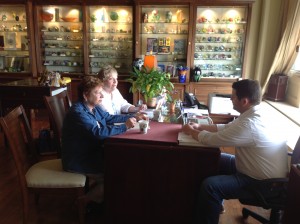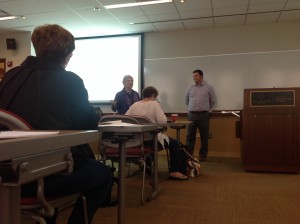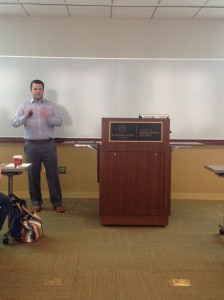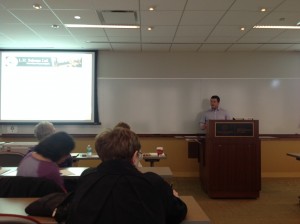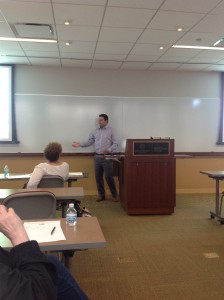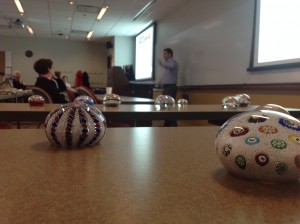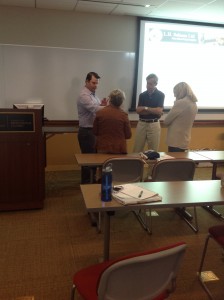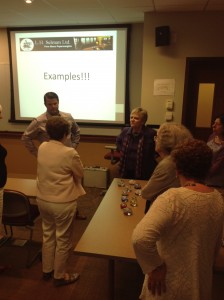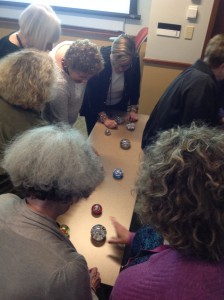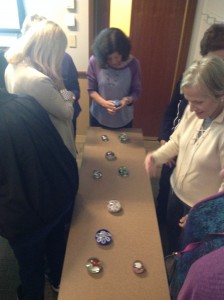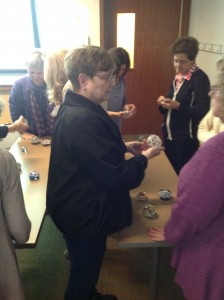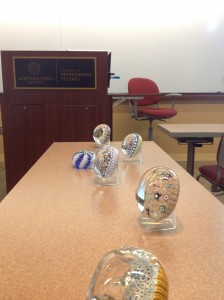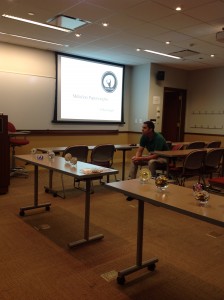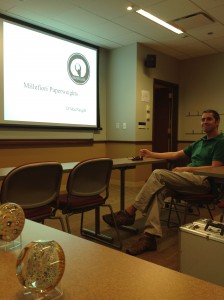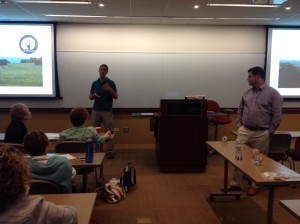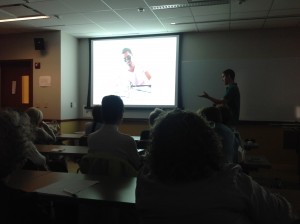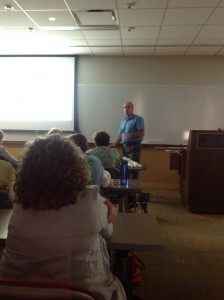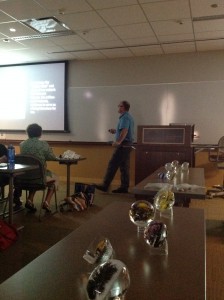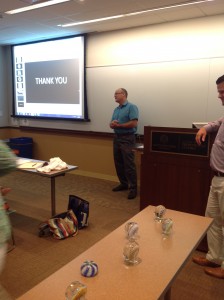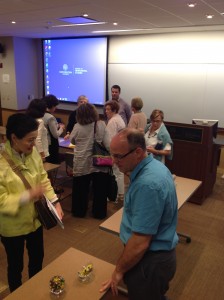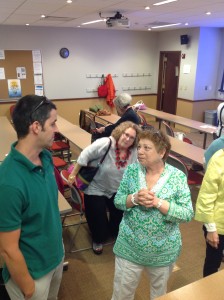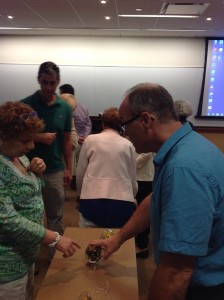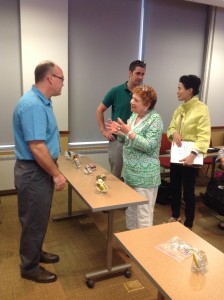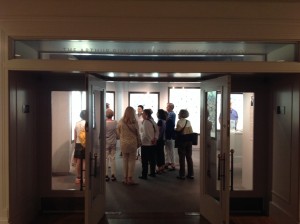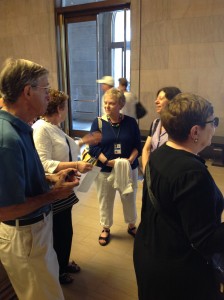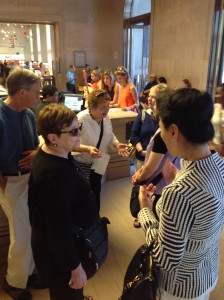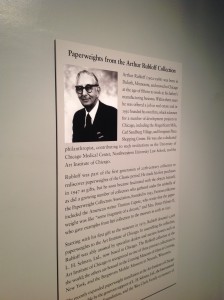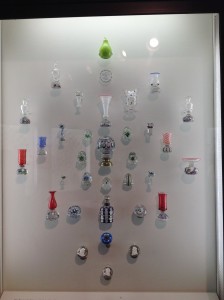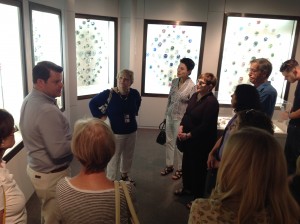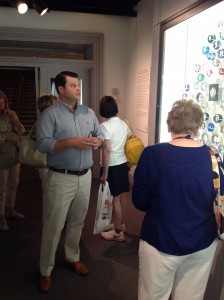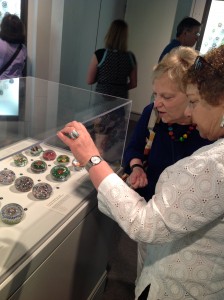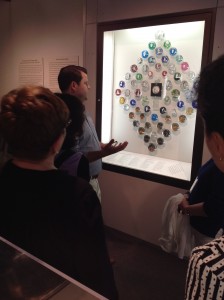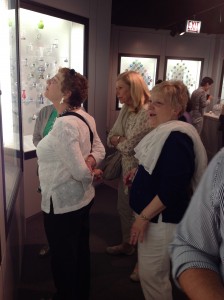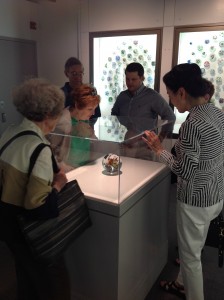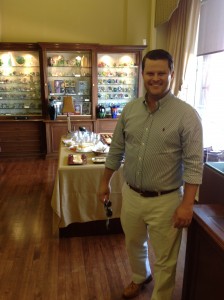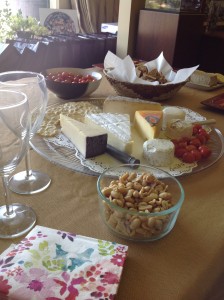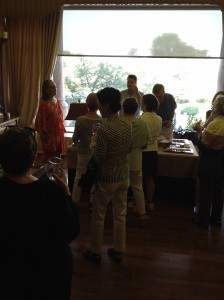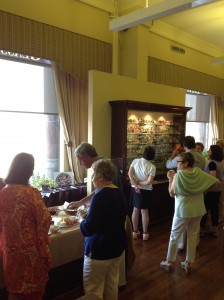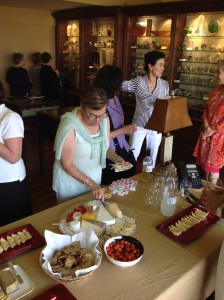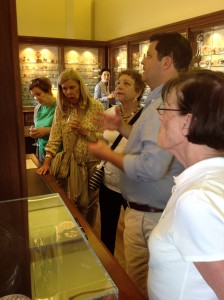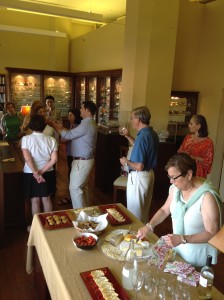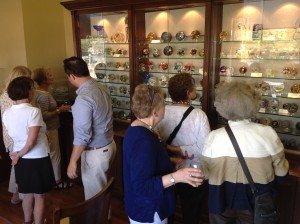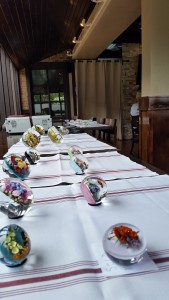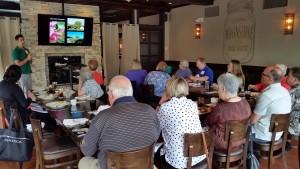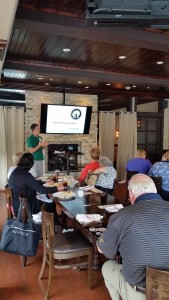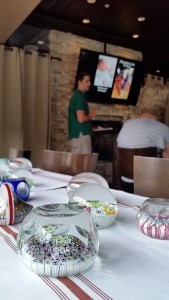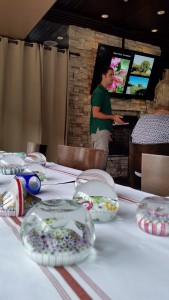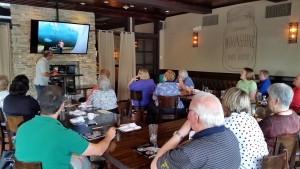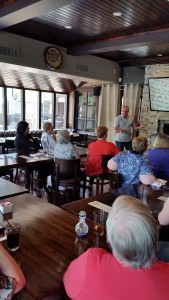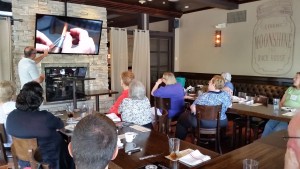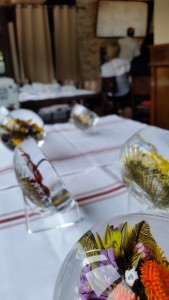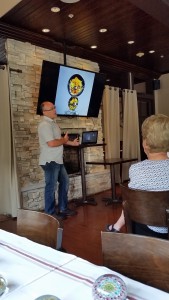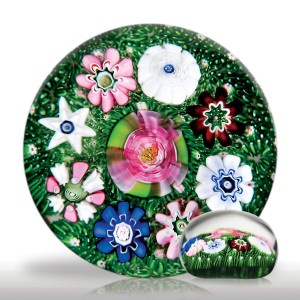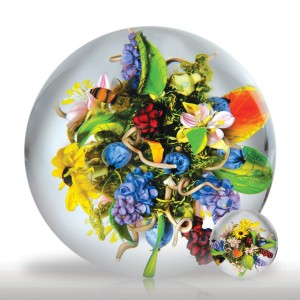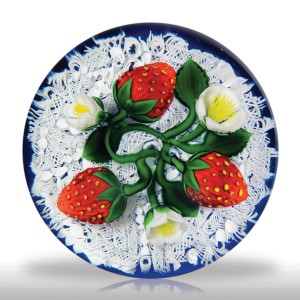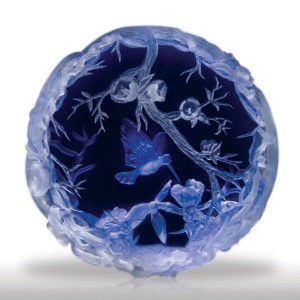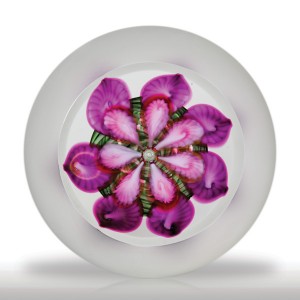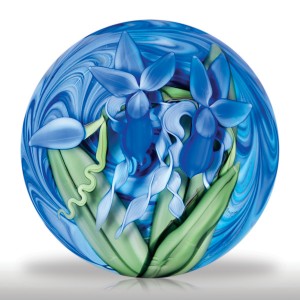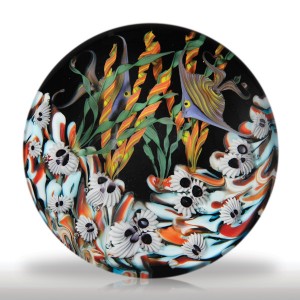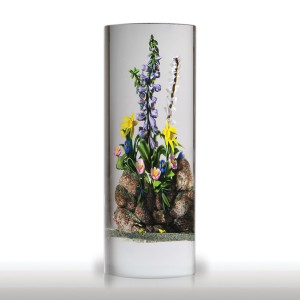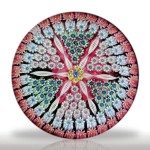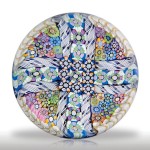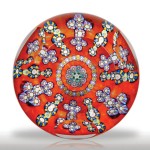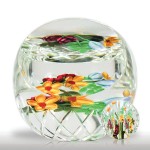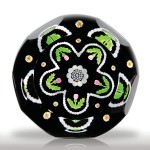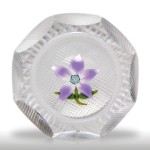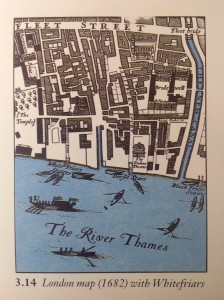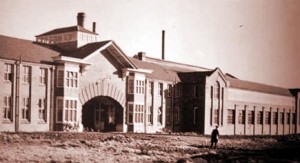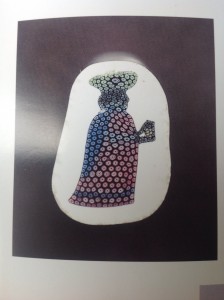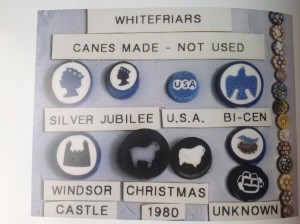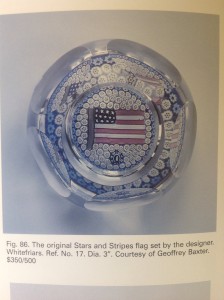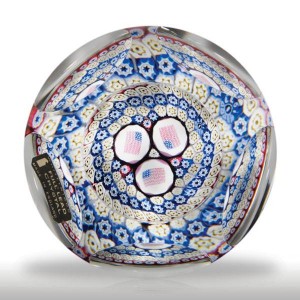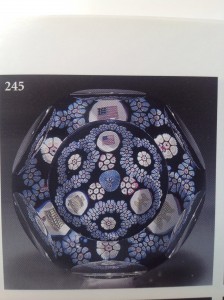The Northwestern OLLI offers adult classes for continuing education: “Composed of seasoned learners from all walks of life, OLLI members pursue learning for pure pleasure: there are no tests and no grades. OLLI’s motto is, “Curiosity Never Retires,” and the OLLI experience proves it!” https://sps.northwestern.edu/program-areas/olli/about_olli.php
Rae and Evelyn approached Mitch Clark, co-owner of L.H. Selman Ltd., about developing a class as an introduction to fine art glass paperweights. They met on June 9th at the L.H. Selman Ltd. gallery, in Chicago, to develop a plan, and thus the class was born! Nearly 20 students enrolled. We gave everyone an A+ just for that!
Chapter 1- July 9, 2015 1:30p, Wieboldt Hall, Room 507, “Maybe there was a view of the lake, but I was too busy looking at paperweights”
The history
Mitch prepared a Powerpoint presentation that traced the paperweight from its conception in European furnaces, nearly 175 years ago, to the ever-evolving artistry of today.
It also highlighted Paul Jokelson’s contribution to the rediscovery of paperweights in the 20th Century and Larry H. Selman’s drive to establish a reliable market and research resources. Mitch and his brother Ben took over Larry’s business when Larry retired in 2009. That was very fortunate for everyone in the class because it meant that the business was moved from Santa Cruz, CA to Chicago! How convenient for these Chicago students!
Mitch showed pictures and a video to explain the process of making a paperweight. Ooos and aaahs ensued. But it is always better to have a look at a real paperweight to grasp its phenomenal intricacies. We think the students agreed.
Ever heard of students that don’t dash out of class as soon as the bell rings? Well, this bunch stayed an extra 45minutes. That is also why we gave everyone an A+!
Chapter 2- July 16, 2015, 1:30p, Wieboldt Hall, Room 507, “YOU made that?!? WOW, HOW?!”
The artists
Two major paperweight artists traveled to Chicago to present to the class. It was a huge treat to have them and Mitch brought good examples of their work to show off to the students. Here are snapshots of their presentations.
Damon MacNaught, the millefiori artist from Tennessee…
Drove in to Chicago a few days before. He studied sculpting at the University of Illinois, so this was somewhat familiar territory.
He still has glass colors that he created in college at his disposal today, but most of his glass comes from Germany and New Zealand now. He teaches design at the college level, raises a family, farms and makes beautiful millefiori canes that he then sets into magical paperweights. He works mostly alone over 2-3 month intervals (while he keeps his glass furnace running), in company of his studio cat and, occasionally, his glass cutting friend Andy Najarian. The difficult part is finding which colors will crack when they cool and never EVER using them again.
David Graeber, the lampwork artist from New Jersey…
Knows everything about South Jersey glass history. Turns out, South Jersey has a lot of good sand to make glass, so it has been a hot spot in the field since the beginning of glass art in the U.S. Still, like Damon, David has to find glass colors that do not crack, which he orders from abroad, but he also scavenges for them in the South Jersey vicinity. He apprenticed with Paul Stankard and in 2008, he built his own 400ft2 studio where the family pool used to be, and started making paperweights independently.
He is a lampwork artist and puts weeks of labor into a single floral design. He then has to encase those in clear crystal, and it’s nerve-racking. A design might not survive the process. Only perfection will be accepted. But as he retains his creative license, he also gives carte blanche to master glass cutter artist, Ed Poore, to decorate the masterpieces. Then he lets his professional photographer take dazzling photographs of his work, and he shared those with us. Ooos and aaahs ensued. We gave everyone A+’s for that too!
The rest of class was spent talking with the artists and looking at their magnificent work. What a treat to be in the presence of the creators of these beauties!
Chapter 3- July 23, 2015, 3:30p, Art Institute of Chicago, Sub Sub Sub basement (not really), “I like that kind, do you have any of those?”
The final class was two part: 1. Visit the tremendous and extensive Arthur Rubloff paperweight exhibit at the Art Institute of Chicago. 2. Visit the L.H. Selman Ltd. gallery, kitty-corner from the Art Institute, for a reception and viewing of the auction lots and gallery displays.
The Rubloff Collection
We gathered in the lobby of the Art Institute of Chicago and contemplated the beautiful ceilings while chatting with the students about circumnavigation adventures in Siberia and other fascinating endeavors.
Then, we headed down to the Arthur Rubloff Collection Gallery in the basement, next to the Thorne Miniature Rooms.
Several visitors were already viewing the collection, but it suddenly became very crowded when we entered. And then it was even more crowded when other curious visitors tried to cram in!
Mitch explained the collaboration between L.H. Selman and the Art Institute in moving the Rubloff Collection to a more accessible location and redoing the curation. What we were visiting today was the product of a successful partnership: the gallery looked modern, freshly painted a sober color with new gray carpet, which contrasted with the brightly colored paperweight displayed on the wall and made them more vibrant.
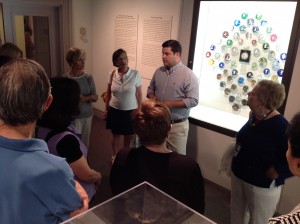
Mitch telling the students detail about the collaboration between L.H. Selman Ltd. and the Art Institute
There were a lot of paperweights, all dated no later than 1979. Everyone took the allotted 30 minutes to read placards and build an opinion about which paperweights were better and which ones had flaws.
Mitch answered a lot of questions and then invited everyone to come to his place of work. The students were anxious to see if the L.H. Selman gallery had their favorite pieces for sale!
L.H. Selman Gallery
Alexis, the L.H. Selman gallery manager, was waiting for everyone with cheese, crackers, amuse-gueules, wine and a warm smile.
Mitch welcomed the class and explained how the gallery was organized. Everyone was off to the races asking Alexis and Mitch questions and exploring the gallery’s little marvels.
We said farewell and every student received a goody gift bag with some hefty reading materials. Mitch received ample thanks and congratulations. For that, everyone received an A+.



